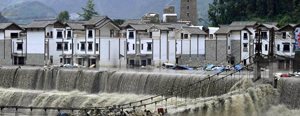 Flash flood disasters happen with little or no warning, and can change the landscape of a city in less than 30 minutes. Between June 1st and July 10th 2013, we have seen the horrifying results of massive flooding in areas such as Southern Alberta, Northern India, Southern China, Pittsburgh, Toronto, among others.
Flash flood disasters happen with little or no warning, and can change the landscape of a city in less than 30 minutes. Between June 1st and July 10th 2013, we have seen the horrifying results of massive flooding in areas such as Southern Alberta, Northern India, Southern China, Pittsburgh, Toronto, among others.
Lives were forever altered, and billions of dollars in losses and damages were incurred, all in merely a few hours. Below grade areas such as basements, subway tunnels, and parking garages are the most vulnerable, and are often the first point of entry for flood water into your home or building. So how can we prepare for this kind of flooding?
Vulnerabilities in Basements
 Pre-existing Cracks
Pre-existing Cracks
Concrete cracks are moistures direct line in to your basement. These cracks may not be visible, but may present themselves as a musty odor, or a wet looking spot, usually high up on the wall. Cracks in your below grade areas must be fixed as soon as possible to prevent the problem from worsening. Although there are many temporary solutions out there for concrete cracks, using a permanent solution that will self-seal hairline cracks, stand up to hydrostatic pressure and last the life of your concrete will provide you with the most value (such as the Krystol Crack Repair system).
Waterproofing failure against Hydrostatic Pressure
When flood waters grow to more than 3 ft. in depth, hydrostatic pressure is created. If your current waterproofing system cannot handle high hydrostatic pressure, concrete will act as a sponge to the water, and crack as the water pressure builds within the concrete itself. Water can also easily penetrate through the joints where walls meet in a corner, or where the wall meets the floor. It can be difficult to predict how vulnerable a concrete joint is until it is too late, so it is important to mitigate any concerns well in advance by administering a permanent jointing system, as well as a waterproofing system that can withstand such high water pressure.
 CLICK HERE to see what one company in New York installed to protect their expensive server equipment after losing thousands of dollars’ worth of equipment to the Hurricane Sandy flooding disaster.
CLICK HERE to see what one company in New York installed to protect their expensive server equipment after losing thousands of dollars’ worth of equipment to the Hurricane Sandy flooding disaster.
In addition to maintaining your basement’s waterproofing to protect against the vulnerabilities within the concrete, there are other actions you can take to protect your dwelling:
1) Have waterproof shields ready to install over all openings, including windows and doors;
2) Perform thorough inspections to the condition of the basement after any kind of heavy rainfall;
3) Keep a pump and generator available, and well-maintained;
4) Do not keep valuable equipment or documents in any crawlspace or basement or, if this is not possible, keep them in a water tight container.
Flash floods happen quickly, and do not discriminate. Taking the time to protect ourselves and our investments is a worthy task that could prove invaluable should such a disaster occur.






